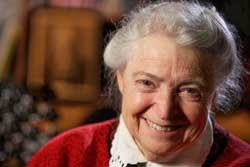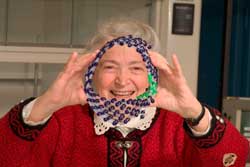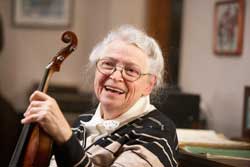Mildred "Millie" Dresselhaus
Brought up in a poor suburb of the Bronx, the young Millie Dresselhaus went to some of the worst schools in New York City. "Things weren't looking to well for me, I was born in the depression - we were one of the many families on welfare". One of the positive things that happened to her was music. As a very young child, Millie received a music scholarship to attend a music school in a settlement house in Greenwich Village, New York. Through that experience she met middle class America - an echelon of society she didn't have any contact with otherwise. She quickly saw that what she was getting in her neighborhood wasn't what "luckier" children were receiving. She decided to switch to a better school, and at the age of 13 enrolled in Hunter College High School for girls.



Mildred "Millie" Dresselhaus
After graduating from Hunter College, Millie was awarded a Fulbright Fellowship which allowed her to spend a year at the Cavendish Laboratory, Cambridge University from 1951- 1952. She received her master's degree at Radcliffe College in 1953. After receiving her PhD, with a thesis on superconductivity 1958, Professor Dresselhaus began her career at the Lincoln Laboratory, where she studied magneto-optics in semiconductors, and carried out a series of experiments which led to a fundamental understanding of the electronic structure of semi-metals, especially graphite. Graphite is a nanomaterial composed of sheets of specially structured carbon atoms a called graphene. Graphene sheets can be rolled up to form carbon nanotubes. She is currently an Institute Professor of Electrical Engineering and Physics at MIT.
With the advent of lasers in the 1960s, Professor Dresselhaus was among the first to use lasers for magneto-optics experiments. In collaboration with Ali Javan, inventor of the continuous wave (CW) laser, she and their joint student Paul Schroeder carried out a high resolution magneto-optics experiment, using circularly polarized light from a helium-neon laser, and in 1968, created a new model for the electronic structure of graphite. These laser studies were the stepping stones to her entry into the field of Raman spectroscopy many years later. Raman spectroscopy is a light scattering technique, where a photon of light interacts with a sample to produce scattered radiation of different wavelengths.
"As for now, I'm still at the forefront of carbon science. I've been very active in the nanotube area. In 2004 and 2005, I entered the graphene domain. Ironically that's where I started back in 1962; we just didn't have samples of monolayer graphene then. These days I'm working mostly on the photophysics of graphene," says Professor Dresselhaus.
Her research has always been multifaceted. "I have another side of me and that's the energy side - this started when I was assistant secretary of the DOE. They asked me to do a hydrogen study, because President [George W.] Bush had the idea that hydrogen was going to be an important energy source, and that led to a whole bunch of other studies. I got back into the science policy area because of that," she says.
Professor Dresselhaus has made promoting opportunities for women in science and engineering a high priority throughout her career. She received a Carnegie Foundation grant in 1973 to encourage women's study in traditionally male dominated fields, such as physics. The same year she was appointed to the Abby Rockefeller Mauze chair, an Institute-wide chair, endowed in support of the scholarship of women in science and engineering.
Reflecting upon her experiences as a woman in physics, Professor Dresselhaus says, "When I first started at Hunter College - that was pretty much a women's college, so I had the idea that women could study physics as well as men. When I got to Cambridge University, there were only a few women but we were doing alright. I didn't really know I wasn't supposed to do physics until I joined the mainstream. When I got my degree in 1958 it was pretty lonely - we [women] were only two percent of the physics community then."
In 1984, Professor Dresselhaus was appointed president of the American Physical Society. "I tried to move APS into a more interdisciplinary mode. I found it one of the most challenging things to overcome, the fact that everyone was so strongly focused in their own avenues of physics."
She continues, "I think we are doing better as physicists at talking to each other and with other fields - because physics doesn't exist by itself, and I think we need to be mindful about that. And I think some of the big discoveries in front us will be in those borderline areas".
After her term as APS president, Professor Dresselhaus served as Chair of the APS Committee on the Status of Women in Physics. Along with former APS Executive Officer Judy Franz, she co - chaired the committees of visiting women physicists, which started in the early 1990s and continues into the present. These committees assess and make recommendations for improving the status of women in physics, with a particular emphasis on undergraduate and graduate students.
In addition, Professor Dresselhaus has also served as President of the American Association for the Advancement of Science, Treasurer of the US National Academy of Sciences, and Chair of the Governing Board of the American Institute of Physics. She has received numerous awards, including the US National Medal of Science and 25 honorary doctorates worldwide. She served as the Director of the Office of Science at the US Department of Energy in 2000 - 2001, and has co - authored many books on carbon science.
Commenting on her research career Professor Dresselhaus says, "If I had never gotten into physics I think I would have gone into school teaching - my entire career I've been very involved with students". When she's not working in her lab at MIT, Professor Dresselhaus enjoys spending time with her large family of four children and five grandchildren, and playing the violin in chamber music groups.
"One of my granddaughters is an undergraduate working on carbon nanotubes - just like grandma! I'm having a great time watching her. If I had to do the whole thing over again, I'd do it exactly the same way."











